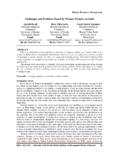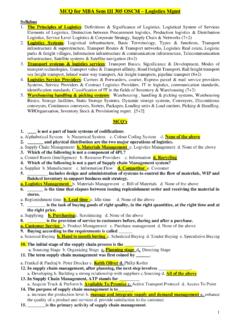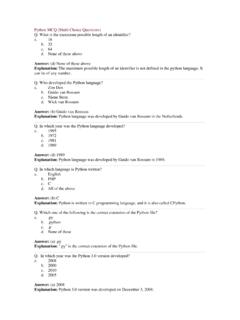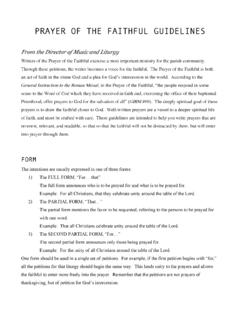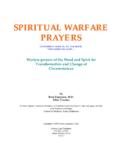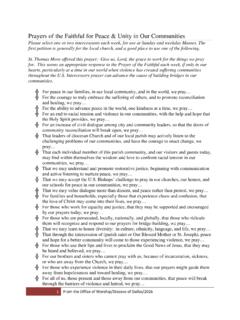Transcription of MCQ with answers on change management
1 MCQ with answers on change management 1) In circumstances of incremental change , strategic change is likely to be more successful if: A. It is imposed B. It is owned by the senior manager C. It is internalized and owned by those who will implement it D. It is facilitated by management consultants 2) 'Logical instrumentalism' can be described as: A. Careful design and planning B. Emergent C. Cautious resource allocation D. Top management rational analysis 3) Organizations that are good at developing relevant capabilities to respond to a Changing context are known as: A. Knowing organizations B. Stretch organizations C. Learning organizations D. None of the given options 4) Which of the following contexts would most suit a transformational leader? A. An organization that is in trouble B. An organization that is performing well C. An organization in a stable environment D. An organization in a mature industry 5) Theorists have identified two main styles of leadership. These are Transformational leadership and: A.
2 Transgression leadership B. Transactional leadership C. Transparent leadership D. Transcendental leadership of the following theories operate on a multiple entity? A. Life cycle and teleological theories B. Teleological and dialectical theories C. Dialectical and evolutionary theories D. Evolutionary and life cycle theories 7. An approach in which an external consultant recommends a solution to organizational problems according to technical view point, is known as: A. Expert system approach B. Devil's advocate approach C. Dialectical inquiry approach D. External analysis approach 8. Which of the following is considered as best decision making approach? A. Expert system approach B. Devil's advocate approach C. Dialectical inquiry approach D. External analysis approach 9. How many stages of biological evolution are there? A. Five B. Four C. Three D. Two 10. Which of the following defines the creation of novel forms of organizations are often viewed to emerge by blind or random chance ?
3 A. Variation B. Selection C. Retention D. Collection 11. What does QMM stand for? A. Quality Marketing management B. Quality management Marketing C. Quality Movement management D. Quality management Movement 12. Identify a theory according to which environment plays decisive role in the selection of forms, processes and practices in organization. A. Life cycle theory B. Teleological theory C. Dialectical theory D. Evolutionary theory 13. What does the acronym TQM stand for? A. Total Quality Manufacturing B. Total Quality Measurement C. Total Quality management D. Total Quantitative Method 14. In terms of organizational change , maintenance of the status quo represents: A. Stability B. Opposition C. Instability D. Contradiction 15. Identify the correct order of dialectical cycle. A. Thesis-Antithesis-Synthesis B. Synthesis-Antithesis-Thesis C. Thesis-Synthesis-Antithesis D. Antithesis-Synthesis-Thesis 1. According to Pettigrew the important aspects of the outer context include: a.
4 The extent of regulation in the industry in which an organization is located b. The presence of other influential stakeholders c. Both (a) and (b). d. None of the given options 2. Which of the following are characteristics of transformational change ? a. systemic and revolutionary b. triggered by environmental disruptions c. driven by all employees d. Both (a) and (b). 3. Among the most common and influential forces of organizational change are the emergence of new competitors and . a. Innovations in technology b. new company leadership c evolving attitudes towards work d. All the given options. 4. Organizational learning interventions emphasize which of the following? a. social processes b. organizational structure c. shared knowledge d . Both (b) and (c). 5. Motivating change , Managing the transition and Shaping the political dynamics of change are prerequisites for installing a change in an organization recommended by .. a. Alex miller c. Simon d. Snow Charles 1. Which of the following strategies refers to slow, gradual or incremental type of change in terms of strategic management ?
5 A. Internal development B. External development C. Revolutionary development D. Radical development 2. Joint venture is an example of which of the following? A. Internal development B. External development C. Revolutionary development D. Radical development 3. Which of the following is one of the dimensions of Greiner's Model? A. Growth rate of the company B. Growth rate of the market C. Growth rate of the economy D. Growth rate of the industry 4. Which of the following is a characteristic of the period of delegation phase? A. Long hours of work are rewarded by modest salaries B. Incentives, budgets, and work standards are adopted C. Accounting systems for inventory and purchasing are introduced D. Profit centers and bonuses are used to stimulate motivation 5. According to Greiner, in his five phases of growth model, what type of crisis follows phase 1. (growth through creativity)? A. Crisis of control B. Crisis of autonomy C. Crisis of leadership D. Crisis of growth 6.
6 When procedures take precedence over problem solving and innovation is dampened, which of the following crisis is created? A. Control crisis B. Autonomy crisis C. Leadership crisis D. Red tape crisis 7. Identify leading proponents of organization ecology model. A. Hannan and Freeman B. Weber and Taylor C. Schein and Quinn D. Mintzberg and Fayol 8. Which of the following is an internal source of structural inertia? A. Sunk cost B. New technology C. Government regulations D. Social legitimacy 9. Identify a scholar who defined specie as a form of organization that exists through generations of individual organizations which are members of the specie". A. Weber B. Hannan C. McKelvey D. Taylor 10. Organizational birth rates and death rates refer to: A. Vital rates B. Growth rates C. Inflation rates D. Reduction rates 1. In environmental determinants, the change in is more crucial. a) Technology b) Organization structure c) Government policies d) None of these 2. According to , the organization's structure consists of five parts including jobs, the authority to do those jobs; the grouping of jobs in a logical fashion, the manager's span of control and the mechanisms of coordination.
7 A) Pettigrew b) Kimberly c) Higgins d) Taylor The organization with narrow span has a disadvantage of . a) Having many levels of management b) Close control c) Close supervision d) Fast communication The management style where management flows from top level to lower levels in organizational hierarchy is called . a) Decentralized system b) Top down management system c) management by objective d) management orientation Successful organizations spend a great deal of their time on . a) Strategy execution b) Strategy planning c) Strategy formation d) Monitoring and controlling 1) Which of the following theories of change posit that individuals and organizations exist in a pluralistic world filled with conflicting interests, ideas, and values? A. Life cycle B. Teleological C. Dialectical D. Evolutionary 2) Which of the following is a dimension of organization structure? A. Departmentalization B. Span of control C. Hierarchy layer D. All of the given options 3) Which of the following is Not included in McKinsey 7 S framework?
8 A. Strategy B. Structure C. System D. Safety 4) Which of the following areas is Not one of the four key areas that strategic change seeks to influence? A. People B. Technology C. Formal organisation structures D. Informal organisation structures 5) In psychology the observation that people often do (or believe) things because many other people do (or believe) the same is called _____. A. Band wagon effect B. Benchmarking C. Fashion D. Trend 1- Changes should not be considered only in terms of the process but should also be considered from historical, cultural and political features. Above statement is given by: a) Andrew M Pettigrew b) Instance Berg c) Philips Kotler d) None of the above 2-Outer context refers to all the given options except: a) Economic environment b) Competitive environment c) Political environment d) Corporate environment Answer: d page 73. Outer context refers to the social, political, economic, business and competitive environment in which the firm operates.
9 Inner context refers to the structure, corporate culture and political context within the firm through which ideas for change have to proceed. 3-The process of change refers to , and from the various interested parties. a) Thinking, implementing and modifying b) Action, reaction and interaction c) Modernization, articulation and appreciation d) Efforts, emotions and prayers 4-The process in the organization in turn depends upon the following except: a) change management b) Pattern through time c) Formulation /implementation process d) Political and cultural views of the firms 5-SOC is the abbreviation of: a) Strategic and operational client b) Strategic organizational change c) Structural and operational control d) Sources of change 6-This is stated to be the requirement of ISO certification that that each and every member should know what their mission, vision, and values are: a) ISO 9000 series standards b) ISO 14000 series standards c) Both (a) and (b). d) Malcom Baldrige Awards 7-In recruitment the following policy (ies) is: a) Whether to hire from within b) Hire from market c) Both (a) and (b).
10 D) None of the Above 8- are objects, events, acts or people which express more than their intrinsic context. a) Habits b) Values c) Symbols d) All of the above 9- Interview procedure that shows a mechanistic and hierarchical organization is: a) Formal interview b) Informal interview c) Longitudinal interview d) One that is conducted with great care an didn't depict anything 10-More specific tactics of change which might be employed to facilitate change process are: a) 4. b) 7. c) 3. d) 6. 1. One of the advantages of a narrow span of control is that: a. Employees can take more Holidays b. A manager can more easily communicate with employees c. Feed back is no longer required from employees d. Fewer appraisals need to be written each year. 2. A tall organization has: a. A small number of managers with wide span of control b. A small number of managers with narrow span of control c. A large number of managers with wide span of control d. A large number of managers with narrow spans of control 3.
